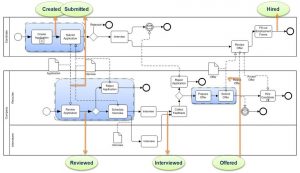A revealing way to view an organization is to realize there are just 2 types of activity in which people are involved: Processes and Collaborations.
 A business process is where people are oriented around a repeatable set of tasks.
A business process is where people are oriented around a repeatable set of tasks.
Processes, short for business processes, are the repeatable chains of tasks that make an organization what it is today, define how well it is performing, how it is experienced by its stakeholders.
A number of core processes such as Order-To-Cash, Procure-to-Pay, Plan-to-Produce, Hire-to-Retire, Concept-to-Customer, for example, unfold into thousands of sub-processes, such as the Invoice Payment process, where action takes place.
You can use techniques such as Six Sigma DFSS and DMAIC to design and improve your processes. On each task, there is an Actor, who hopefully does what is expected of them. Repeatable processes are well defined, structured, and managed through hundreds of Key Performance Indicators (KPI’s).
Today, with over 30 years of process design and improvement experience in the world, we expect new processes to quickly be operating at high levels of performance and stay there. Someone failed when that does not occur.
 A collaboration is a group of people who need to determine what action will be taken around a one-time topic.
A collaboration is a group of people who need to determine what action will be taken around a one-time topic.
Collaborations, on the other hand, are a group of people coming together around a shared topic, needing to decide what action will be taken.
Your collaborations determine where your organization will be tomorrow. They determine its trajectory, its rate of progress, its agility.
We have currently mapped over 90 common organizational collaborations, from business strategy revision, to merger integration planning, to outsourcing contracts, and software implementations.
Interestingly, because the people, the context, the inputs and the outputs, are unique, groups see little connection between their collaboration and any other. However, what they all have in common is that they are a group of people coming together around a unique topic to decide where they will take it.
Imagine the difference in your organization’s progress over a single year if your collaborations were slow, inefficient, and unclear, with few achievements, versus collaborations that were rapid, efficient, clear, and achieved their potential. It’s the difference between a soap-opera and a gazelle.
Unfortunately, in contrast to new processes, most people have high hopes for each new collaboration, and are disappointed, but not surprised, when they take too long, too much time, and yield only some of their potential.
We need to get Collaborations where Processes are today – highly reliable, highly efficient, highly effective.